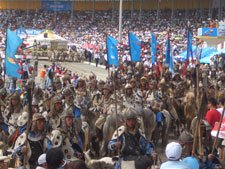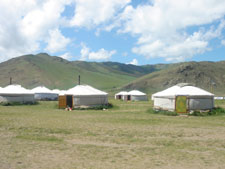 The great beast of an ox pulls the sturdy cart, upon which sits a small replica of a traditional 'ger'. The president takes prime position on a frontal platform. The procession is led by more than a hundred Mongol horses which seem oblivious to the clapping and cheering. The cavaliers are dressed in traditional armour and costume imitating that originally worn by Genghis' great army.
The great beast of an ox pulls the sturdy cart, upon which sits a small replica of a traditional 'ger'. The president takes prime position on a frontal platform. The procession is led by more than a hundred Mongol horses which seem oblivious to the clapping and cheering. The cavaliers are dressed in traditional armour and costume imitating that originally worn by Genghis' great army.This opening ceremony of the Nadaam Festival was the first real highlight of our tour. The Mongolian cultural highlight of the year, it is a 3 day festival which takes part at the beginning of July. It started in the 12th Century before the time of the great ruler. The festivities were banned during the Soviet era however the event began again once the Russians left Mongolia. It is a festival of three male sports: wrestling, horse racing and archery, to show who is the strongest and the best. Ultimately it praises their great hero.
Otherwise known as Chinggis, or 'Great Ruler', Genghis Khan lived from 1162 to 1227. A great warrior, his real name was Temuchu (iron man). Considered so terrifying, many cities surrendered upon mere rumours of his impending invasion, as his army trampled Asia and beyond. In 1206 he reunited all of the Mongol tribes to create one of the largest empires ever to exist. Today he lives on as a symbol of Mongolian independance and democracy.
After an introduction to the city we ventured into the vast great wilderness of Mongolia and the gobi desert for 8 days and nights, to ty to get a glimpse of the traditional nomadic way of life. 43 percent of Mongolians still live as nomads in gers which are easy to build, dismantle and restore. Camps are moved twice a year to cope with seasonal change. During the mild summer months nomads travel to flatlands near to a water supply, and in September to a valley or by a mountain to shelter from the harsh winter.
Tourist ger camps are designed to replicate this way of living to

a certain extent. Although fairly basic, the camps are surprisingly clean and comfotable, powered either by solar power or a generator. Collapsible cedarwood frames are covered by sheep's wool felt, with a central stove and carpeted wooden floor. In the evenings the Mongolian camp staff serve a hearty meal of grilled lamb and dumplings, and entertain with the haunting sound of 'hoomi' throat singing.
For the most part bathroom facilities are shared, but some camps are building 'deluxe' gers which have a self contained wooden cubicle attached to the side. In one camp we experienced an infestation of harmless beetles which took residence in our gers, they could be heard dropping to the floor in the night. After the rain there was a distinct smell of goat which in fact was the smell of damp felt. Minor distractions these were though. Nothing compares to waking up to see farmers herding their livestock, the lush green meadows beyond and vivid blue skies: a landscape which could resemble that of utopia.
The Gobi is a land of extremes. Decent rain only falls every two or three years, it can be well over 40 degrees in the summer and below minus 40 degrees in the winter. Storms of dust and sand are fearsome in spring. We travelled off road in comfortable jeeps, our experienced drivers seemed to have inbuilt compasses in their heads there were certainly no signposts. Our vivacious guide Ari, whose knowledge of the area was outstanding, enthused us all the way. Regular stops allowed us to enjoy the scenery and relieve ourselves. (There are no porterloos in the dessert, any modesty was quickly overcome out of sheer necessity). As we travelled further south the scenery changed and so did the wildlife. As well as sand dunes and red cliffs and arid desert we saw green valleys, steep mountains, small farms and nomadic herds. Yaks resembling big fluffy cows drank out of ponds as horses bathed in rivers and an ox and cart passed by.
Other unusual wildlife we saw along the way included bearded vultures (the largest flying birds in the world), enormous wild rams, ibexes, camels (an entertaining time was had when we had a chance to ride these), and the' takhi' horse. The only remaining breed of wild horse in the world, these were re- introduced into the Hustain Nuruu National Park during the 1960s after nearly becoming extinct. Resembling zebras without stripes, the animals are sandy coloured with black manes and tails, and look almost prehistoric.
Possibly the most fascinating of all the sights are the Bayanzag Flaming Cliffs, which were discovered in 1922 by American explorer Roy Andrews Chapman. The scenery resembles that of Arizona and here is one of the best places in the world for palaeontology. A red sandstone area, bones literally stick out and whole dinousaur eggs lie on the ground. A complete dinosaur model, the bones of which were all found at Bayanzag, is kept in the splendid museum of Natural History in Ulaan Baatar.
A few monasteries survived Stalin's purges. Remains exist in Karakorum, the ancient capital of the Mongol empire. Originally one of the biggest cities on the original Silk Road, it was eventually completely destroyed and material from the ruins was used to build the fabulous Erdene Zu monastery. The beautiful Gandan Monastery in Ulaan Baatar also survived, since the Russians used it to stable their horses.
Mongolia has to be seen to be beleived. Mild stomach ache brought on as a result of drinking airag (fermented mares milk) and being stuck in the desert for an hour whilst our jeep was fixed all added to the experience. The rewards of the trip cannot be put into words. Now is really the time to visit, before the inevitable concrete roads and luxury camps appear.
Marie-Louisa Lowther
